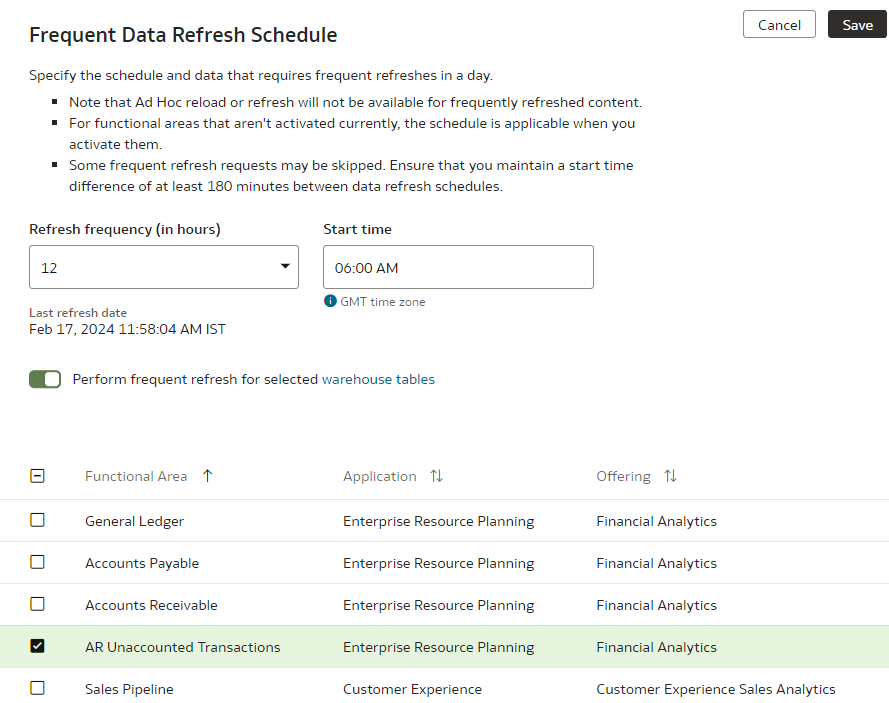Schedule Frequent Refreshes of Data
You can schedule frequent refreshes of the applicable functional areas, prioritized datasets, and warehouse tables to ensure that the incremental data in these is the latest.
You can refresh a limited set of tables currently with plans to support more functional areas and datasets in future releases. While opting to refresh certain functional areas, prioritized datasets, and warehouse tables, ensure to understanding which tables you can refresh or not because the selective refresh of some tables could lead to functional inconsistencies when combining data from multiple subject areas. This frequent data refresh capability is designed for refresh of base tables that capture the transactional data; it isn't meant for derived datasets that require aggregations, snapshots, or complex transformation logic. Such processing creates data latency that doesn't support high volume of frequent data refresh.
If you've enabled the "Prioritized Data Refresh" preview feature and selected datasets for a prioritized incremental refresh, then those specific datasets are available for a frequent data refresh. See Prioritize Datasets for Incremental Refresh (Preview). If you've enabled the "Frequent Refresh Tables" preview feature and saved your selection of the warehouse tables, then the selected tables are available as "Warehouse Tables" for a frequent data refresh. See Schedule Frequent Refreshes of Warehouse Tables. If you want to select the warehouse tables created by the custom data configurations that were generated prior to release Platform 23.R4, then you must regenerate the applicable custom data configurations for these tables to be visible for selection. From release Platform 23.R4, the warehouse tables created by the custom data configurations are available for a frequent data refresh under the Frequent Refresh tab.
For Oracle Fusion Data Intelligence, you can schedule frequent refreshes for functional areas that are visible in the Frequent Data Refresh Schedule tab on the Pipeline Settings page.
When you select the functional areas for a frequent refresh, you won’t be able to refresh the data pipeline for the applicable functional area using the Refresh Data option on the Data Configuration page. The frequent data refresh process doesn't refresh data from external sources through the data augmentation connectors. Oracle Fusion Data Intelligence processes the data augmentations as part of the incremental loads. For frequent data refreshes, the semantic model won't be updated. The update jobs for semantic model won't run as part of data augmentations, they run for data augmentations only during incremental loads.
- During the last five days of the month or every quarter, general ledger data changes quickly with updated entries more than once a day. In this scenario, a financial analyst wants to ensure taking more recent and accurate data into the analysis and report generation. Because some of the data pipelines can take several hours to execute from end to end, the frequency of refresh needs to be every 4 hours or 6 times in a 24-hour period.
- In this scenario, a retailer that has strict guidelines for returns or refunds on any purchase orders, and needs to bring in the most recent order data for computation and report generation, especially in the beginning of a given fiscal quarter. To cover for time differences between Europe, East Coast, and West Coast of the U.S., a financial analyst needs to refresh data every 8 hours in 24 hours, or 3 times a day.
Ensure that Frequent Refresh is enabled in Pipeline Features under the Generally Available Features tab on the Enable Features page prior to scheduling frequent data refreshes. See Enable Generally Available Features.
